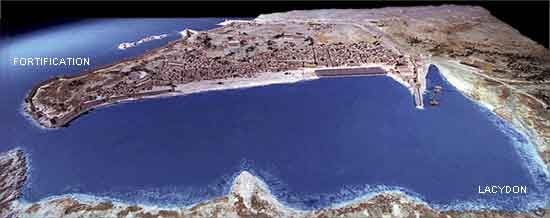- Home
- Gauls and Greeks
- Relations with Greek Marseilles
- Greek Marseilles during the 3rd and 2nd centuries BC
Model of Marseilles during the Hellenistic peiod. Marseilles History Museum.
During the Hellenistic period, the Greek City covered an area of around 50 hectares, linking three hills to the north of the cove of Lacydon. During the second half of the 2nd century BC, it was delimited by a new fortification of monumental dimensions. Except for the port sector and its docks, which were recently excavated, we know very little about the residential area and the principal monuments (temples, theater, public cistern, presumed agora. Nonetheless, there are several well attested traces of logical planning. Several necropolises are known in the surrounding area.
The monumental architecture was constructed with large-sized blocks made with local or regional limestone. Meanwhile, many of the dwellings were made with unbaked mud bricks and cob roofs, following the example of the Entremont settlement. This urban particularity, noted by Vitruve, shows that the fundamental differences between Massalia and the largest settlements of the surrounding Celto-Ligurian communities are more closely related to the internal organization of the city, and the associated organization of human relations, than to the techniques of construction.
Ships in the port of Marseilles (models). Marseilles History Museum.
Ships in the port of Marseilles (models). Marseilles History Museum.
The great Greek City of the far West
While economic relations with the surrounding territories (including the chora, which was not suitable for cereal crops) were important for supplying the Greek City with necessary resources, most of its activities were centered on maritime relations and ocean resources.
During the 3rd, and beginning of the 2nd century BC, two new colonies, Tauroeis (Le Brusc) and Nikaia (Nice), were established in order to reinforce protection of the coast.
Marseilles and Rome
Due to its association with the Mediterranean coast, and its secular alliance with Rome, Marseilles was implicated in the first two Wars of the 3rd century BC. In return, Marseilles received assistance Roman military support in 154 against Ligurian attacks on the colonies of Nice and Antibes.
In 124 and 123 BC, Rome again intervened on behalf of the Greek city against the Celto-Ligurian federation of the Salyens just outside the city. The military defeat of the federation troops allowed Marseilles a temporary moment of peace.
However, the Roman troops continued occupying Aix-en-Provence. Now on the left bank of the Rhone, they completed their occupation of the region, which had been initiated in Languedoc starting from Spain. The new prosperity of the Greek city would from this time on be expressed only by the economic influence of the Italian negotiatores, until its total loss of independence in 49-48 BC


